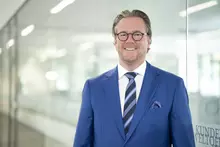
Philip Harting
Position: Chairman of the Board
- Company: HARTING Technology Group
On the way from sector-based to open technologies
Social and technological developments are becoming increasingly interdependent: Decarbonisation, sustainability as well as extreme demographic changes are meeting technical megatrends such as AI, digital twins and modularity. Due to the diverse challenges, a common goal is needed that all industries must work towards in the interests of a sustainable world.
All Electric Society (AES) = climate-neutral electrified, digitalised world
Given all the diverse challenges, a common goal is needed that all industries must work towards in the interests of a sustainable world. Since 1996, HARTING has been pursuing a vision that has become ever more topical: “We want to shape the future with technologies for people.”
This vision casts a broad, encompassing vision of the future, the All Electric Society. It stands for a highly electrified and digitalised world in which the key criteria for climate neutrality are met. In order to achieve this, the relevant sectors must work together. HARTING has outlined an overall picture of these sectors in which the areas of energy, agriculture, infrastructure, mobility and industry have converged and interact.
Until now, these fields have partially formed separate ecosystems. In order for the sectors to converge, we need to accompany the transition from individual, sector-based to open technologies and the associated standards even more consistently. The links between the individual industries will be energy - in this case electricity - and data streams. Today, technology standards such as Ethernet IEEE 802.3, the digital twin standard IDTA, ODCA for uniform direct current technology and the OPC UA for standardised data exchange are already offering significant leverage for sector coupling.
Drivers of progress: international standards and innovative product diversity.
The international standards provide an important orientation for our products. This does not, however, make individual requirements superfluous. Take connectors: Here, the environmental conditions within the sectors, such as submerge application scenarios, for example, remain the characteristic distinguishing features that we must take into account in our product development.
This opens up opportunities for innovative companies to expand their own portfolios, particularly in view of the All Electric Society. For HARTING, these are the connectors that are to an ever increasing degree becoming the lifelines between the sectors. And so, our vision is embarking on a new chapter of its evolution: Connecting the All Electric Society!

Detlef Sieverdingbeck
Position: General Manager Corporate Communication & Branding
- Department: CCB
- Company: HARTING Stiftung & Co. KG
